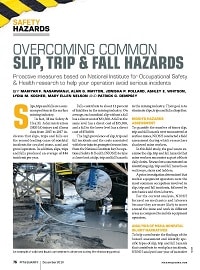Mining Publication: Overcoming Common Slip, Trip and Fall Hazards
Original creation date: December 2019
Authors: M Nasarwanji, A Mayton, J Pollard, A Whitson, L Kocher, M Nelson, P Dempsey
Slips, trips and falls are a common problem in the surface mining industry. In fact, Mine Safety & Health Administration (MSHA) injury and illness data from 2015 to 2017 indicates that slips, trips and falls are the second-leading cause of nonfatal incidents for crushed stone, sand and gravel operators. In addition, slips, trips and falls produced an average of 446 incidents per year. Falls contribute to about 11 percent of fatalities in the mining industry. On average, each nonfatal slip without a fall has a direct cost of $33,500. A fall to the same level has a direct cost of $35,300, and a fall to the lower level has a direct cost of $50,000.
The high prevalence of slip, trip and fall incidents and the costs associated with these injuries prompted researchers from the National Institute for Occupational Safety & Health (NIOSH) to take a closer look at slip, trip and fall hazards in the mining industry. Their goal is to eliminate slips, trips and falls altogether.
